Did you know that sea asparagus, also known as Salicornia europaea or samphire, is considered one of the most nutritious and versatile marine vegetables? This edible seaweed, commonly referred to as sea pickle, sea beans, or sea greens, offers a host of benefits that have captured the attention of health-conscious individuals and culinary enthusiasts alike.
Sea asparagus has gained popularity in recent years due to its nutritional value and unique flavor profile. From its high mineral content to its potential anti-aging properties, sea asparagus is a marine powerhouse that deserves a place in your diet.
Key Takeaways:
- Sea asparagus, also known as Salicornia europaea or samphire, is a versatile marine vegetable.
- Sea asparagus is packed with essential minerals, vitamins, and potential anti-aging properties.
- It can be sustainably grown in saltwater ponds, such as those at Olakai Hawaii.
- Samphire, a nutrient-rich sea vegetable similar to sea asparagus, offers various health benefits.
- Green salt, derived from sea asparagus, is a low-sodium alternative that adds a unique flavor to dishes.
The Health Benefits of Sea Asparagus
Sea asparagus, also known as Salicornia europaea or samphire, offers a wide range of health benefits that make it a valuable addition to any diet. Let’s delve into the numerous advantages that this unique marine vegetable provides.
1. Folic Acid for Skin Health
Sea asparagus is a rich source of folic acid, also known as vitamin B9. This essential nutrient plays a crucial role in promoting healthy skin and has even been hailed as one of the next anti-aging foods. By incorporating sea asparagus into your meals, you can help improve the overall health and appearance of your skin.
2. Vital Vitamins and Electrolytes
Sea asparagus is not only loaded with folic acid but is also a great source of vitamin B2 and electrolytes. Vitamin B2, also known as riboflavin, is essential for various bodily functions, including the production of energy and maintaining healthy skin, eyes, and nervous system. Electrolytes, such as sodium and potassium, are vital for maintaining proper hydration, nerve function, and muscle contractions. Including sea asparagus in your diet ensures a significant boost in vitality.
3. Betaine for Anti-Aging and More
Sea asparagus is renowned for being the richest known source of betaine, a compound that plays a crucial role in methylation, a vital biochemical process in the body. Methylation is involved in various functions, including the control of aging-related problems. Betaine has shown potential in combating aging-related issues such as hearing loss, memory loss, osteoarthritis, diabetes, and depression. By incorporating sea asparagus into your diet, you can support methylation and potentially reduce the risk of aging-related problems.
Sea asparagus is not just a tasty addition to your meals; it also offers a plethora of health benefits. From promoting skin improvement to boosting vitality and supporting methylation, sea asparagus is a powerhouse of nutrients. Incorporate this marine vegetable into your diet for a natural anti-aging ally and support for a healthier, more vibrant you.
Olakai Hawaii – A Sustainable Sea Asparagus Farm
At Olakai Hawaii, we are proud to be a pioneering farm that specializes in the cultivation of sea asparagus and Ogo. Located in the scenic saltwater ponds of Kahuku, Hawaii, our farm utilizes a unique hydroponic system to grow these nutritious sea vegetables sustainably.
Unlike traditional vegetable crops, sea asparagus and Ogo thrive in our saltwater ponds, where they symbiotically coexist and grow. We employ an innovative anti-algae saline aquaculture system that ensures the clean and safe production of sea asparagus and Ogo. By operating on an open saltwater hydroponic system, we create an environment that promotes the growth of these sea vegetables while minimizing the use of natural resources.
Our commitment to sustainable farming practices extends beyond just production. We believe in providing our customers with clean and safe products that they can trust. That’s why all our sea asparagus and Ogo undergo stringent quality control measures to guarantee their freshness and nutritional value.
You can find our delicious sea asparagus and Ogo products at local health food stores and supermarkets. Alternatively, you can visit our website, olakaihawaii.com, to explore our range of sustainably grown sea vegetables and have them conveniently delivered to your doorstep.
Join us in supporting sustainable farming and enjoy the incredible taste and health benefits of Olakai Hawaii’s sea asparagus and Ogo!
Samphire – A Nutrient-Rich Sea Vegetable
When it comes to sea vegetables, samphire is a true powerhouse. Also known as sea asparagus or sea pickle, samphire is packed with a variety of essential minerals and nutrients, making it a valuable addition to any diet.
One of the standout features of samphire is its impressive mineral content. It is rich in minerals such as magnesium, potassium, calcium, and sodium, which play vital roles in maintaining the body’s overall health and functioning.
In addition to minerals, samphire is also a great source of dietary fiber, which is essential for digestive health and promoting feelings of fullness. Its high fiber content makes samphire a great option for those looking to improve their digestion and maintain a healthy weight.
Moreover, samphire is packed with vitamins A, B, and C. Vitamin A is important for promoting good vision and healthy skin, while B vitamins play a crucial role in energy production and maintaining a healthy nervous system. Vitamin C, on the other hand, is a powerful antioxidant that supports the immune system and helps protect the body against oxidative stress.
One unique component of samphire is its fucoidan content. Fucoidans are compounds commonly found in sea vegetables and are known for their anti-inflammatory and antioxidant properties. The presence of fucoidans in samphire further enhances its potential health benefits.
With its low-calorie and low-fat content, samphire is a nutritious addition to any diet. Whether enjoyed raw in salads, pickled, or cooked as a side dish, samphire offers a burst of flavor and a wealth of health benefits.
Take a closer look at the nutrient profile of samphire in the table below:
| Nutrients | Quantity per 100g |
|---|---|
| Magnesium | 58mg |
| Potassium | 135mg |
| Calcium | 110mg |
| Sodium | 103mg |
| Dietary Fiber | 2.2g |
| Vitamin A | 414 IU |
| Vitamin B | 0.178mg |
| Vitamin C | 6.6mg |
With its immense nutritional value, samphire is a sea vegetable that shouldn’t be overlooked. Incorporating this nutrient-rich gem into your meals can provide you with a wide range of health benefits and a delicious addition to your plate.
The Health Benefits of Samphire
Samphire, also known as sea asparagus, offers a variety of health benefits that can enhance your overall well-being. Let’s explore some of the remarkable advantages that samphire brings to the table.
Digestion and Inflammation Reduction
One of the notable benefits of samphire is its high dietary fiber content, which aids in digestion and promotes a healthy gut. The fiber in samphire helps prevent constipation and reduces inflammation in the digestive system, allowing for better nutrient absorption and waste elimination.
Immune System Support and Antioxidant Properties
Samphire is rich in vitamins A and C, which play crucial roles in supporting a strong immune system. These vitamins act as antioxidants, protecting the body against oxidative stress and preventing damage caused by free radicals. By incorporating samphire into your diet, you can give your immune system a valuable boost.
Bone Health and Sleep Regulation
Calcium is essential for maintaining strong bones, and samphire is a good natural source of this mineral. Regular consumption of samphire can contribute to optimal bone health, reducing the risk of osteoporosis and fractures. Additionally, samphire’s magnesium content helps regulate sleep patterns by promoting relaxation and restful sleep.
Weight Loss and Inflammation Reduction
For those aiming to shed a few pounds, samphire can be a valuable addition to a weight loss diet. With its low-calorie and low-fat nature, samphire offers a nutritious option that can help in reducing weight. Furthermore, the antioxidant properties of samphire contribute to the reduction of inflammation throughout the body, supporting overall well-being.
By incorporating samphire into your meals, you can enjoy its numerous health benefits and add a flavorful and nutritious element to your diet.
Green Salt – A Low-Sodium Alternative
Looking for a healthier alternative to table salt? Look no further than green salt, also known as sea asparagus. Not only does it provide a savory umami flavor, but it also offers a range of essential nutrients to support your well-being.
Unlike regular table salt, which is known for its high sodium content, green salt is a low-sodium option that can be enjoyed without the guilt. But that’s not all – it’s packed with beneficial minerals like magnesium and potassium, which are essential for various bodily functions.
One standout component of green salt is its chlorophyll content. Chlorophyll is a natural pigment found in plants, and it gives green salt its vibrant color. This compound has been associated with numerous health benefits, including improved digestion, detoxification, and wound healing.
When it comes to vitamins, green salt is a good source of vitamin B3, also known as niacin. Vitamin B3 plays a crucial role in energy production, DNA repair, and cellular function, making it an important nutrient for overall health.
But green salt isn’t just about nutrition. It also adds a unique flavor to your dishes, thanks to its subtle hint of seaweed. This umami taste enhances the overall taste profile of your meals, taking them to the next level of deliciousness.
Many chefs use green salt as a finishing salt, sprinkling it on top of fish, seafood, and roasted vegetables to add a burst of flavor. Its versatility makes it a great addition to any kitchen pantry, allowing you to experiment with different recipes and elevate your culinary creations.
If you’re concerned about the presence of monosodium glutamate (MSG), rest assured that green salt doesn’t contain it. However, its umami flavor makes it a natural flavor enhancer, providing a similar taste experience.
“Green salt is a game-changer in my kitchen. It adds a unique depth of flavor to my dishes, and I love how it’s a healthier alternative to regular salt. It’s become an essential ingredient in my cooking.” – Chef Maria
So why not give green salt a try? It’s a low-sodium alternative that brings a wealth of benefits to your table. Whether you’re looking to reduce your sodium intake, add more nutrients to your diet, or elevate your cooking, green salt is a must-have ingredient.
Nutritional Comparison: Green Salt vs. Table Salt
| Nutrient | Green Salt (1 tsp) | Table Salt (1 tsp) |
|---|---|---|
| Magnesium | 42mg | 0mg |
| Potassium | 90mg | 0mg |
| Chlorophyll | Present | Absent |
| Vitamin B3 (Niacin) | 0.5mg | 0mg |
| Sodium | 62mg | 2325mg |
As shown in the table, green salt outshines table salt in terms of magnesium, potassium, chlorophyll, and vitamin B3 content. In contrast, green salt contains significantly less sodium compared to table salt, making it a healthier choice for those watching their sodium intake.
So why settle for ordinary salt when you can enjoy the benefits of green salt? Add this low-sodium alternative to your kitchen and elevate your meals with its unique flavor and nutritional value.
Nutritional Value and Potential Health Benefits of Green Salt
Green salt, derived from salicornia or sea asparagus, offers a range of nutritional benefits. This innovative low-sodium alternative contains a balanced combination of vitamins, minerals, and antioxidants. Let’s take a closer look at the nutritional value and potential health benefits of green salt.
Nutritional Profile of Green Salt
Green salt is packed with essential vitamins and minerals that contribute to overall health and well-being. Here is a breakdown of some key nutrients found in green salt:
| Nutrient | Function |
|---|---|
| Magnesium | Supports nerve function, helps build strong bones, and plays a role in energy metabolism. |
| Copper | Assists in the production of red blood cells, supports the immune system, and aids in collagen formation. |
| Vitamin B3 | Plays a vital role in energy production, aids in DNA repair, and supports the function of the nervous system. |
| Antioxidants | Help combat free radicals, protect cells from damage, and support overall cellular health. |
Potential Health Benefits of Green Salt
Green salt contains bioactive phytochemicals that have been associated with various health benefits. Here are some of the potential health benefits of consuming green salt:
- Anti-inflammatory properties: The antioxidants found in green salt may help combat inflammation in the body, reducing the risk of chronic diseases.
- Anticancer effects: Certain phytochemicals in green salt have shown promising anticancer properties, inhibiting the growth of cancer cells.
- Antihypertensive properties: Studies suggest that green salt may have the ability to help regulate blood pressure levels, promoting cardiovascular health.
- Antimicrobial properties: Some research indicates that green salt possesses antimicrobial properties, which may help fight against harmful bacteria and pathogens.
- Antidiabetic effects: Preliminary studies suggest that green salt may have the potential to help regulate blood sugar levels, making it beneficial for individuals with diabetes.
While human research is limited in this area, the potential health benefits of green salt are promising. Studies have shown positive effects on brain health, heart health, liver function, and the reduction of inflammation and hypertension.
It’s important to note that green salt should be consumed as part of a balanced diet and in moderation. Consulting a healthcare professional before making any significant dietary changes is always recommended.
Lowering Sodium Intake with Green Salt
Green salt offers a delicious solution for individuals seeking to reduce their sodium intake without compromising on flavor. As a low-sodium alternative to table salt, green salt provides a healthier option that promotes overall well-being. Excessive consumption of sodium has been linked to various health concerns, including high blood pressure, diabetes, and obesity.
By substituting traditional table salt with green salt, you can not only enhance the flavor of your dishes but also take proactive steps towards improving your health. Green salt contains a lower sodium content, making it an ideal choice for those looking to manage their sodium intake.
Additionally, green salt offers additional health benefits beyond just sodium reduction. It is a rich source of potassium, an essential mineral that helps regulate blood pressure and supports overall cardiovascular health. Incorporating green salt into your diet can contribute to maintaining healthy blood pressure levels, reducing the risk of heart-related ailments.
Furthermore, green salt has the potential to help regulate gut bacteria balance, which plays a crucial role in maintaining good overall health. An imbalance in gut bacteria has been linked to various health conditions, including obesity and insulin resistance. By incorporating green salt into your meals, you can support a healthy balance of gut bacteria and potentially reduce the risk of these conditions.
To make the switch to green salt, simply use it as a direct replacement for traditional table salt in your recipes. Whether you’re seasoning a savory dish or sprinkling it over roasted vegetables, green salt adds a mild yet satisfying flavor that enhances the taste of your food.
By embracing green salt as part of your culinary repertoire, you can enjoy flavorful meals while reducing your sodium intake and promoting good health.
Benefits of Green Salt:
- Low-sodium alternative to table salt
- Enhances flavor in dishes
- Promotes a healthy balance of gut bacteria
- May help reduce the risk of high blood pressure, diabetes, and obesity
- A rich source of potassium for cardiovascular health
Incorporate green salt into your diet and savor the flavor while taking care of your health. Say goodbye to excessive sodium and hello to a deliciously low-sodium alternative.
Sodium Content Comparison
| Salt Type | Sodium Content |
|---|---|
| Green Salt | Low |
| Table Salt | High |
Conclusion
Sea asparagus, samphire, and green salt are three remarkable options that offer numerous health benefits and culinary versatility. Incorporating these ingredients into your diet provides a unique and beneficial way to enhance your health and culinary experiences.
Sea asparagus, also known as the “Ginseng of the Sea,” not only possesses anti-aging properties but is also a rich source of essential nutrients. Samphire, a nutrient-packed sea vegetable, supports various bodily functions due to its abundance of minerals and vitamins. Green salt, a flavorful low-sodium alternative, allows you to reduce sodium intake while adding a savory touch to your dishes.
By incorporating sea asparagus, samphire, or green salt into your cooking, you can enjoy the health benefits they offer while exploring new culinary possibilities. Embrace the remarkable taste and versatility of these ingredients and discover a world of flavors that nurture your well-being.

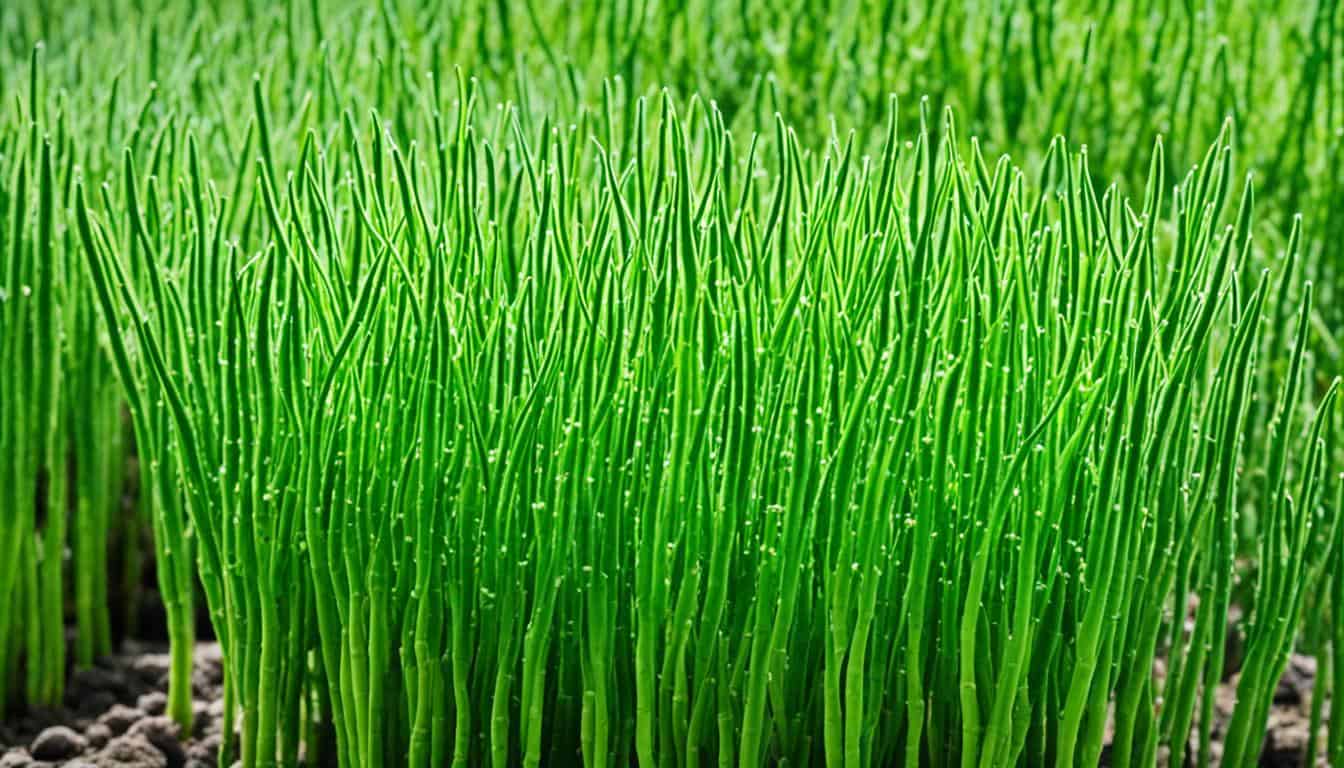

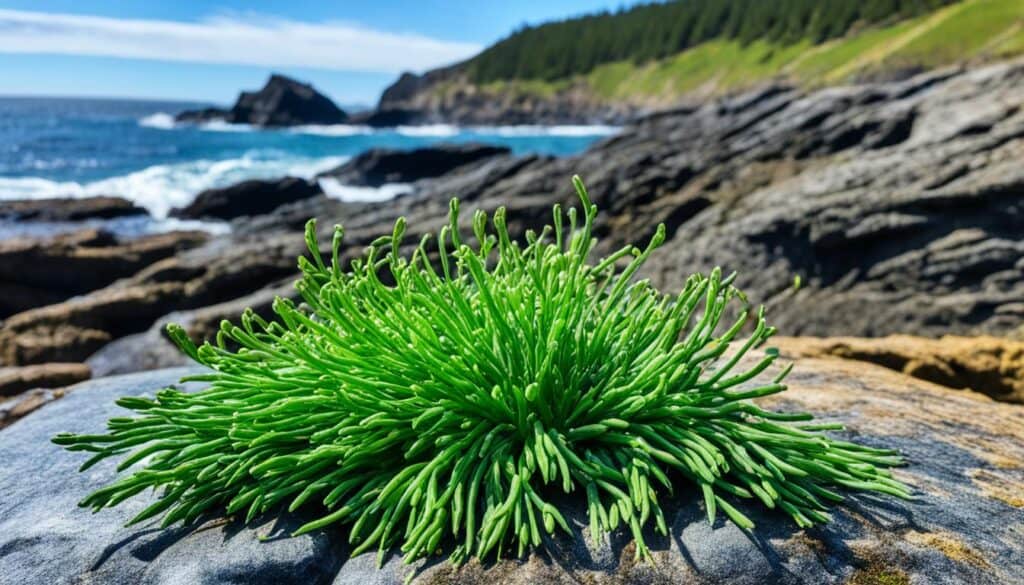
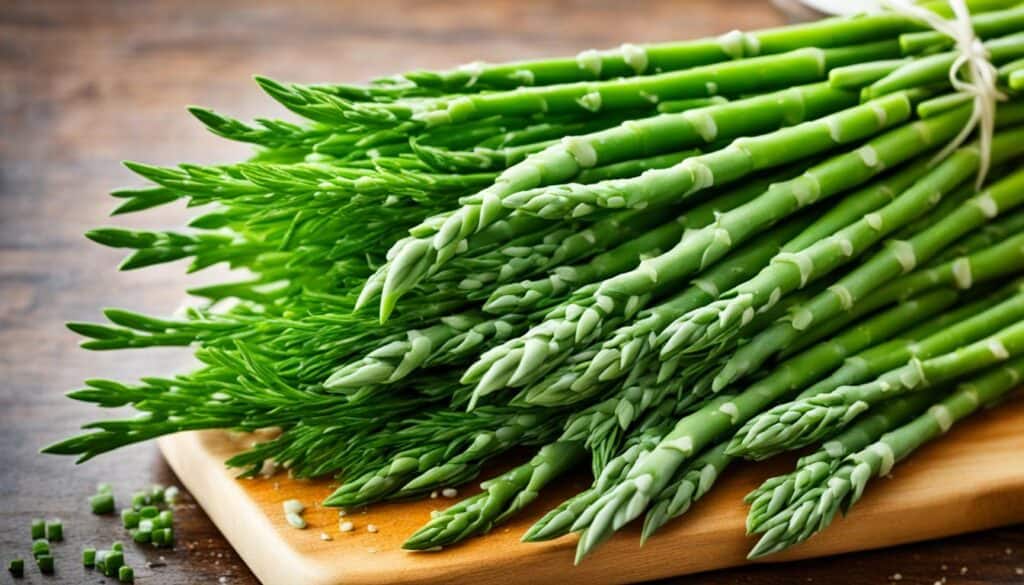
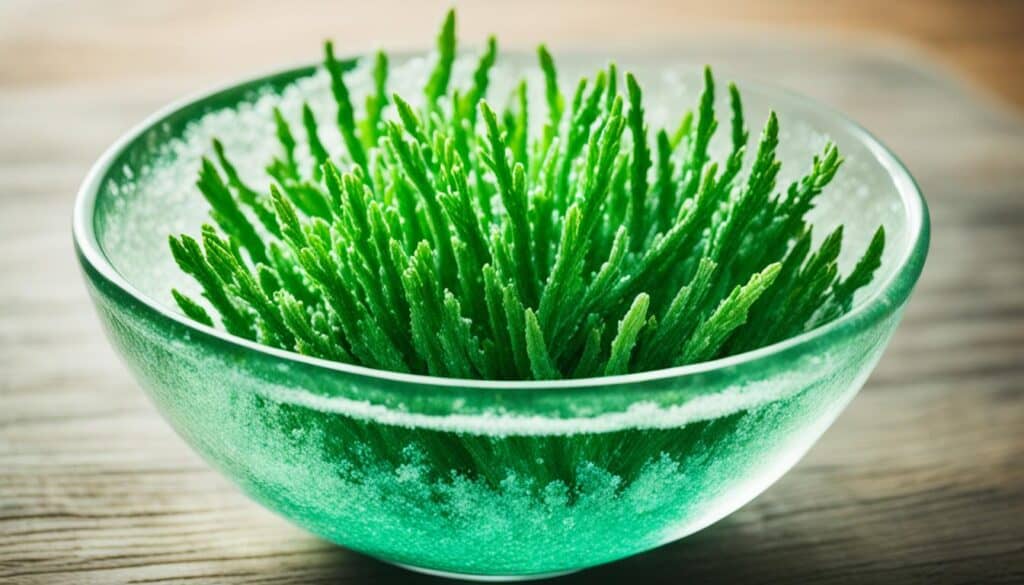
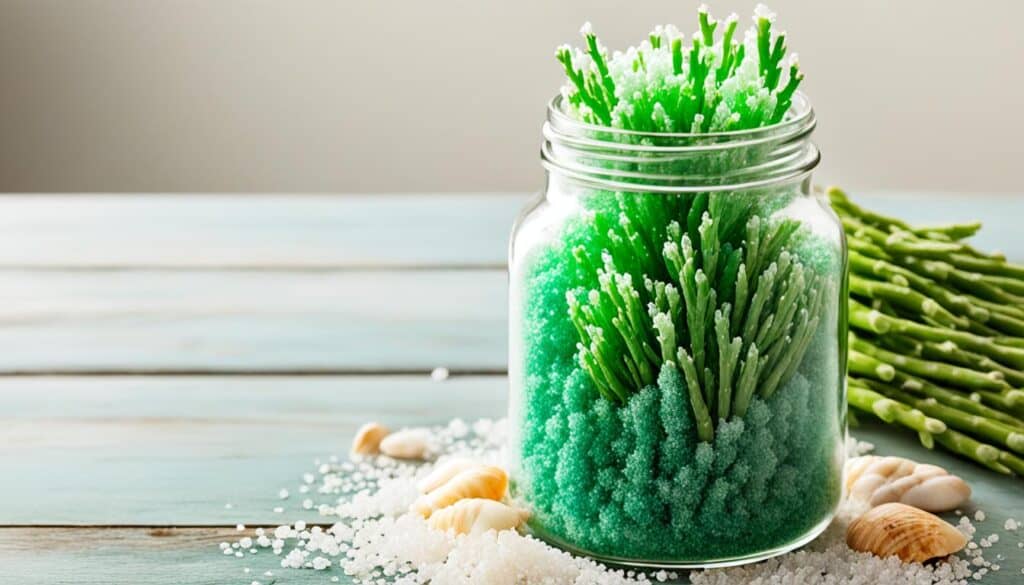



Leave a Reply